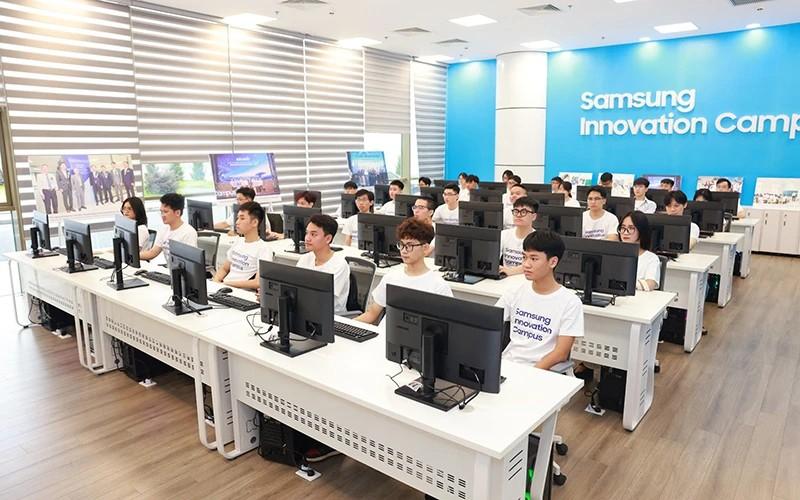The Government of Vietnam has been taking drastic and prompt measures to seize the opportunity to join the global semiconductor supply.

On May 3, the Vietnam National Innovation Centre (NIC) and Samsung Vietnam officially kick-started a technology talent development programme called ‘Samsung Innovation Campus (SIC)’ for the academic year 2023-2024 in Ha Noi.
The SIC is the first joint effort between Samsung Vietnam and the NIC to realise the goal of training 50,000 semiconductor engineers by 2030.
According to the Memorandum of Understanding on cooperation in implementing high-tech education and development projects signed between Samsung Vietnam and NIC in late 2023, the two sides will coordinate to organise six training classes on high technology for about 200 students from universities across the country.
Samsung Vietnam is one of NIC's major partners in implementing high-tech education and development projects to foster technology talent, turning Vietnam into an innovative hub in the region and the world.
It is also a key part of a project worth 26 trillion VND (1.02 million USD) on human resources development in the semiconductor industry to 2030, with a vision to 2045 that the Ministry of Planning and Investment has submitted to the Government for approval.
The project is said to be a quick systematic move of Vietnam in the semiconductor-relating race that is getting hotter around the world.
In the first phase of the project, Vietnam will focus on human resources training for the stages of design, packaging, testing and those related to the production of equipment, materials and chemicals.
Minister of Planning and Investment Nguyen Chi Dung said that with abundant and quality labour supply, human resources have become Vietnam's biggest and most prominent advantage compared to other countries and economies in the world.
Therefore, focusing on investing, training, and retraining to enable the workforce to enter the market as soon as possible is a strategic direction and a decisive factor for Vietnam to seize opportunities for cooperation, investment, technology access and transfer, thus promoting rapid and sustainable economic development which is based on science, technology and innovation, Dung said.
Recent positive movements in policies and actions have demonstrated Vietnam's determination to participate more strongly in the global semiconductor ecosystem.
Seeing the favourable investment environment and advantages in human resources, large global corporations have increased investment in Vietnam’s high technology and semiconductor industries.
The semiconductor industry ecosystem has been formed in Vietnam with more than 50 enterprises, most of them are foreign-invested enterprises such as Intel, Amkor, Hana Micron in packaging and testing; Ampere, Marvell, Cadence, Renesas, Synopsys in design and Lam Research, Coherent in equipment manufacturing.
Major Vietnamese enterprises such as FPT and Viettel are also taking part in the design stage that accounts for 53% of the chain value.
In Vietnam, the new development trend of high-tech industries has changed quickly in the past half a year, especially when the Hoa Lac NIC facility came into operation. Following Intel or Amkor, other "eagles" are also eyeing investment in Vietnam, for example, the US’s NVIDIA.
After the visit to Vietnam by President and CEO of the US chip giant Jensen Huang in December 2023, Vice President of the group Keith Strier also paid a working visit to Vietnam in April 2024 to explore investment cooperation opportunities in the semiconductor and AI industry.
Minister Dung said that in the semi-conductor race, timing is a key decisive factor, which requires Vietnam to take prompt and drastic actions to nurture its semiconductor ecosystem and seize opportunities.
TB (according to VNA)